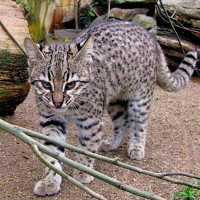 |
Geoffroy cat |
|
He is a wild animal |
Origin |
South America | |
Translation |
Francis Vandersteen |
| The possession of this animal is not authorized Royal Decree establishing the list of mammals not kept for production purposes that may be kept (M.B. 24.08.2009) |
| Geoffroy's cat is one of the 10 cat species found in South America. The lineage that led to the genus Leopardus, which comprises 7 species including Geoffroy's cat, was the first extant feline lineage to arrive in South America 10 to 12 million years ago, soon followed by those of the genera Puma (puma and jaguarondi) and Panthera (jaguar). Geoffroy's cat and its 2 closest relatives, the kodkod and colocolo, used to be grouped in the genus Oncifelis, but today they are considered to belong to the genus Leopardus, like most other small South American felines. Cats of the genus Leopardus have a genetic peculiarity compared to other felines: while other felines have 19 pairs of chromosomes, Leopardus cats have only 18. Geoffroy's cat coat varies from gray to tawny-gray. It is marked with small black spots, which meet on the head and legs to form stripes, and the tail is ringed in black. Chin, belly and chest are lighter, cream to white. Like most felines, Geoffroy's cat also has black ears with a white spot in the center. As in no fewer than 16 other feline species, black Geoffroy cats can also be found, affected by a recessive mutation called melanism. Melanism appears to be common in Geoffroy cats, both in the wild and in captivity. In some regions, up to half of all Geoffroy cats may be black. The Geoffroy cat may well qualify as a small cat. While most small felines are larger than domestic cats (barely larger than the puma, the 4th largest feline), Geoffroy's cat is about the same size as our living-room fawn. It measures from 70 cm to around 1 m in length, with a tail of 25 to 35 cm, and stands 15 to 25 cm at the withers. Their weight is usually between 4 and 6 kg, but we've seen Geoffroy cats weighing as little as 2 kg, and on the other end of the scale, almost 8 kg. Geoffroy cats from the south of the species' range, living in colder environments, are slightly larger than those from the north. Males are larger than females. The Geoffroy cat is a solitary nocturnal predator of small animals. Like many small felines, it is a skilled hunter of rodents. These, along with hares, insects and small lizards, make up the bulk of its diet. Geoffroy's cat is not afraid of water, and he's also a fan of fish and frogs. His fishing skills have earned him the nickname "fishing cat". To find its daily ration of prey, the Geoffroy cat scours its territory every night, ranging from 2 to 6 km2 for females and up to 12 km2 for males. |






 English (United Kingdom)
English (United Kingdom)